Lime: composition and useful properties of the fruit, application features
Lime is a type of citrus plant that used to be popular only in the countries of South Asia, but now takes pride of place in European stores. This fruit is used in cooking as a cosmetic and medicinal product. The healing properties of the fruits are diverse: regenerating, antiseptic, antimicrobial, wound healing, sedative, antioxidant, diuretic and choleretic.
Despite what many consider lime absolutely harmless, contraindications do exist. Therefore, before using lime for the treatment and prevention of diseases, it is necessary to consult with your doctor.
The content of the article
What is lime
Lime is a citrus plant of the Rutaceae family. Place of origin - India, Malacca Peninsula. It is genetically similar to lemon, however, unlike the latter, it bears fruit in a humid tropical climate, therefore in the tropics it is the "main" citrus.
Lime fruits are small - 3-6 cm in diameter, egg-shaped, juicy, sweet and sour pulp. Depending on the variety, the rind is yellow or green and very thin when fully ripe. The plant blooms and bears fruit all year round. The main harvest is in August - October.
For reference. The shelf life of the fruits is 1.5-2 months at a temperature of + 9 ... + 11 ° C and a relative humidity of 85-90%.
Citrus is mainly cultivated and supplied from India, Mexico, Cuba, Egypt. Many varieties and hybrids of lime have been developed, differing in taste, nutritional and medicinal properties. The most popular variety is Mexican.
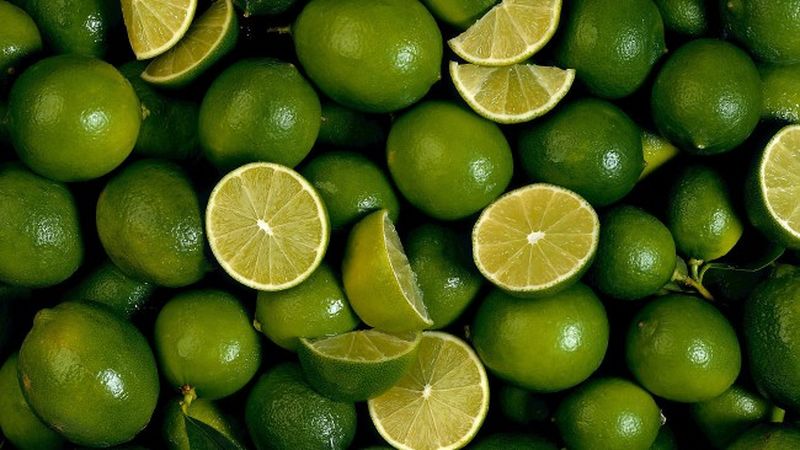
Calorie content and chemical composition of lime
The calorie content of lime is 30 kcal per 100 g, the content of proteins / fats / carbohydrates is 0.7 g / 0.2 g / 7.7 g.
Chemical composition:
- organic acids;
- alimentary fiber;
- water;
- Sahara;
- vitamin A;
- beta carotene;
- vitamins B1, B2, B4, B5, B6, B9;
- vitamins C, E, K, PP;
- trace elements: iron, manganese, copper, selenium, zinc;
- macronutrients: potassium, calcium, silicon, sodium, magnesium, sulfur, phosphorus;
- amino acids;
- fatty acids: omega-3, omega-6, myristic, palmitic, stearic, linoleic, linolenic.
Useful properties of lime for humans
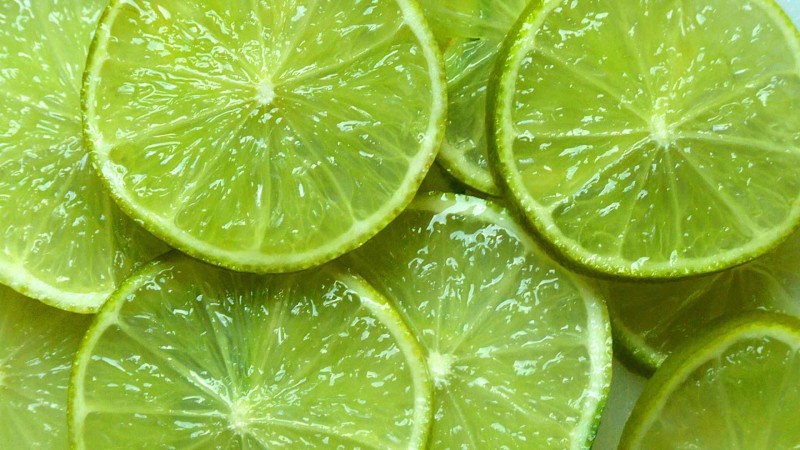
Lime contains many biologically active components that determine its medicinal properties. With regular use, citrus restores health, improves overall well-being, increases endurance and working capacity, prevents many diseases, and accelerates recovery in the presence of pathologies.
Useful properties of lime fruit:
- suppresses the intensity of inflammatory processes;
- disinfects;
- accelerates tissue regeneration in case of wounds and burns;
- reduces the severity of pain;
- increases the body's resistance to infections;
- slows down the aging process;
- neutralizes dangerous free radicals;
- regulates metabolism;
- activates digestion;
- has an antibacterial effect;
- stimulates the nervous system, reduces the manifestations of depression;
- eliminates smooth muscle spasm;
- normalizes blood circulation and lymph flow;
- increases the density and elasticity of the vascular walls;
- reduces the risk of heart and vascular diseases;
- cleanses the liver and kidneys;
- removes toxins and toxins from the intestines;
- supports the proper functioning of the sweat and sebaceous glands;
- improves the condition of the skin, hair, nails.
The benefits and harms of lime for the body depend on the amount, appropriateness and correctness of use. Citrus has contraindications that you need to familiarize yourself with before using it for therapeutic or prophylactic purposes.
Lime helps maintain weight and shed those extra pounds. It contains dietary fiber, the main action of which is a natural and safe cleaning of the body without disturbing the intestinal microflora.
How does weight loss occur:
- Normalization of digestive processes. Pectin stimulates intestinal motility, food moves easier and faster through the gastrointestinal tract, does not linger, which ensures regular bowel movements, helps to cope with constipation.
- Fast and long-lasting saturation. Dietary fiber is not digested, entering the intestines, swelling and creating a feeling of fullness. This reduces the amount of food consumed and helps to avoid snacking. As a result, more energy is consumed than comes from food, and the body begins to waste fat reserves.
- Removal from the body of harmful substances (toxins, toxins, pesticides), reducing the concentration of cholesterol and glucose in the blood.
- Decreased insulin production. Due to the low glycemic index (32 units), the level of glucose in the blood increases gradually, without overloading the pancreas.
- Maintaining normal intestinal microflora, restoring the disturbed balance of microorganisms.
- Energy saturation for a long time, increasing endurance and performance.
How fruit is useful for a woman's body
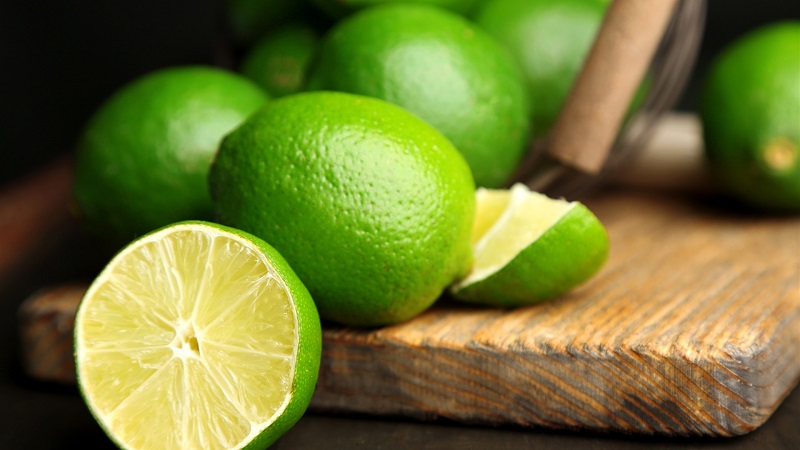
During pregnancy and lactation, lime serves as a source of vitamins, minerals, amino acids responsible for the health and well-being of women. Folic acid is of particular value at all stages of pregnancy. A deficiency of this vitamin adversely affects the state of the nervous system of the unborn child and can cause the development of serious defects: congenital heart and vascular pathologies, spina bifida, hydrocephalus, and cerebral hernia.
A rich vitamin and mineral complex has a positive effect on reproductive function: it slows down the onset of menopause, relieves menopause symptoms, restores and maintains hormonal levels. Regular use of lime serves as the prevention of gynecological diseases of an inflammatory nature (vaginitis, adnexitis, vulvitis) and caused by hormonal changes (polycystic disease, uterine fibroids, menstrual irregularities).
B vitamins have a positive effect on the functions of the nervous system, increase stress resistance, improve emotional state, normalize night sleep, and provide good mood and well-being.
For men
How is lime good for men's health? Zinc and selenium in the fruit stimulate the production of testosterone, which is responsible for sex drive and sexual health.
Vitamins C and E cleanse blood vessels from cholesterol, minimize congestion, provide sufficient blood supply to the corpus cavernosum, which is necessary to achieve and maintain an erection. Due to its pronounced antioxidant properties, lime reduces the likelihood of developing testicular cancer and prostate pathologies.
Potassium and magnesium keep the smooth muscles of the penis in good shape, vitamins and fatty acids ensure the metabolism in the cavernous tissues, which helps prevent the onset of erectile dysfunction.
For reference. Citrus has aphrodisiac properties, enhances sexual desire.
Benefits for children

For children and adolescents, citrus serves as an additional source of vitamin C, which is necessary for the normal functioning of the immune system, all types of metabolism, and the absorption of iron.Its deficiency leads to bleeding and looseness of the gums, nosebleeds due to increased permeability and thinness of the capillaries.
Lime to some extent satisfies the body's need for calcium, which strengthens the skeletal system, helps prevent damage to the musculoskeletal system, and is important for teeth.
Lime is a natural and safe immune stimulant. In the season of colds, it protects against acute respiratory viral infections and acute respiratory infections, facilitates their course, and prevents complications.
How to consume lime
Fresh lime is a ready-to-eat product. Peel it off and eat it in slices, sprinkled with sugar or salt. In India, citrus fruits are salted and pickled. However, for greater benefit, nutritionists recommend eating fresh fruit pulp, since any heat treatment reduces the content of nutrients.
Unpeeled lime can be eaten, but the zest contains a lot of essential oils that give the fruit a bittersweet taste and aroma.
How and with what to eat lime
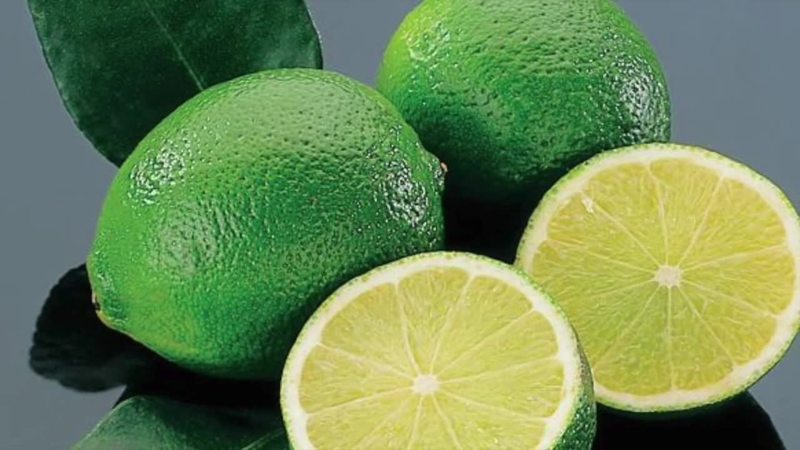
The fruits are eaten fresh, processed into juice, added to smoothies, fruit cocktails, tea, vegetable and fruit salads, served with meat, poultry, fish. In salads, lime is in harmony with non-acidic fruits: pear, apple, peach, apricot, melon.
Fresh juice used for pickling vegetables and meat, as a dressing and flavoring additive. The zest is used to decorate cocktails and pastries, add to baked goods, jams, puddings, ice cream. A few drops of citrus juice are appropriate in cream soups, fresh vegetable salads, fruit juices. The fruits are in harmony with almost all products. How to eat lime and what with it depends on personal taste preferences.
Lime wedges are added to tea. A cold drink quenches thirst, tones, refreshes, energizes and invigorates; hot relieves fatigue, relaxes, normalizes sleep. To improve the taste, grated root is added to it. ginger, cinnamon, mint leaves, lemon balm, nutmeg.
Where is the fruit used
In addition to cooking, lime zest and pulp are used in folk medicine as medicinal raw materials, as well as for cosmetic purposes.
With existing pathologies, it is used in combination with the main therapeutic methods. Citrus enhances the effect of drugs, accelerates recovery, and prevents complications.
In folk medicine
Lime is used to treat and prevent the following diseases:
- Diseases of the respiratory system, acute respiratory viral infections, acute respiratory infections, in which cough worries, a feeling of sore throat, fever. Citrus has antipyretic and antibacterial properties, increases the body's natural defenses.
- Neurological disorders, insomnia. Acts as a sedative, eliminates the feeling of tension, facilitates the process of falling asleep, improves the quality of sleep.
- Prevention of diseases of the cardiovascular system (ischemia, myocardial infarction, atherosclerosis). Strengthens the walls of blood vessels, lowers the level of bad cholesterol in the blood, promotes normal blood flow, preventing the formation of sclerotic plaques.
- Rheumatic diseases (gout, arthritis, arthrosis, osteoarthritis). It dissolves crystals of uric acid salts and painlessly removes them from the body, inhibits inflammation, reduces the severity of pain, and normalizes the exchange of purines.
- Arterial hypertension. It normalizes blood pressure, reduces the tone of veins and the volume of circulating blood, reduces the load on the heart muscle.
- Constipation. Stimulates intestinal motility, normalizes water-salt balance, liquefies feces, facilitates bowel emptying.
- Infections. Possesses antibacterial and antiviral activity, destroys or prevents the growth of pathogenic microorganisms, does not allow their spread to other organs and systems.
- Avitaminosis.Replenishes the deficiency of micro- and macroelements, vitamins and other valuable components that take part in metabolic processes, physiological reactions.
- Skin diseases, including papillomas, warts, dermatitis, herpes. Accelerates tissue regeneration, reduces inflammation.
- Pathology of the digestive system. Restores disturbed structures and functions of the liver, increases the secretion of bile, regulates metabolism, removes free radicals and toxic substances from the body.
- Anemia. Serves as an additional source of iron, improves its absorption, reduces the severity of symptoms from the nervous system (headache, irritability, weakness, dizziness).
- Obesity, diabetes mellitus. It controls blood sugar levels, accelerates the breakdown of fats, removes excess fluid from the body, and relieves edema.
In cosmetology
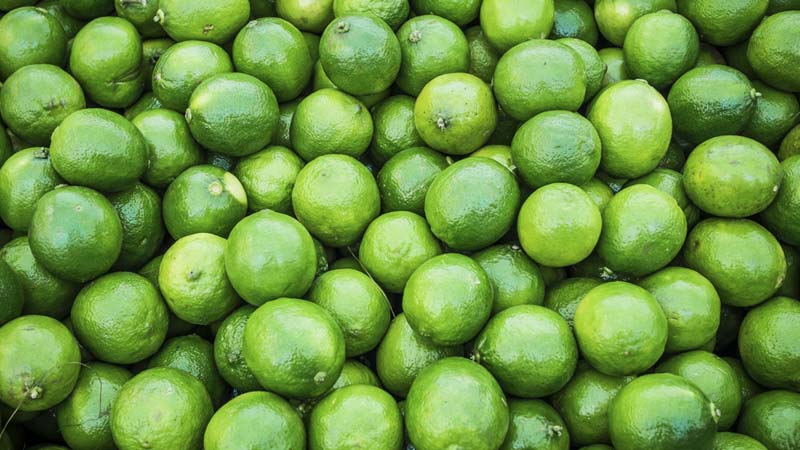
Lime is a popular cosmetic product. At home, it is used for facial and body skin care. Citrus contains high doses of vitamin C, which stimulates collagen production, prevents the formation of early wrinkles, and slows down the aging process.
Lime reduces the severity of age spots on the skin, protects it from the negative effects of UV rays. Acids have an exfoliating effect, gently remove the upper stratum corneum, improve tissue nutrition. As a result, the skin acquires a healthy and uniform complexion. Lime has tonic, nourishing and moisturizing properties, tightens pores, removes comedones, restores water balance.
For reference... Cosmetologists recommend that women with oily and problem skin pay special attention to lime. Citrus juice controls the sebaceous glands, reduces sebum production, and prevents the formation of comedones.
Lime juice has a positive effect on the condition and health of hair. As a component in homemade masks, it reduces the activity of the sebaceous glands, nourishes and stimulates the follicles, improves the condition of the scalp, strengthens and restores hair, and promotes its active growth. Juice is used to lubricate the head with seborrhea, to strengthen weakened and thin hair, oily at the roots.
Slimming water with lime
Water with lime not only relieves excess weight, but also normalizes metabolism, cleanses the body of accumulated toxins and toxins. This vitamin remedy protects against flu and colds, with regular consumption, it keeps the whole body in good shape.
It is simple to prepare a drink: add the juice of half a lime to 200-250 ml of room temperature water.
Optionally, you can put 1 tsp. natural honey. Honey enhances the dietary and absorbent properties of citrus fruits, activates the process of breaking down fats, stimulates intestinal peristalsis, as a result of which weight loss is more effective.
Take the drink daily on an empty stomach. Morning food intake is possible no earlier than half an hour later.
Contraindications and possible harm
Lime is contraindicated in individuals with citrus allergies. It is recommended to limit its amount or completely exclude it from the diet in the presence of such diseases and conditions:
- a stomach or duodenal ulcer;
- erosive gastroduodenitis;
- gastrointestinal bleeding;
- increased acidity of gastric juice;
- renal / hepatic impairment.
In the absence of contraindications, lime will not harm your health. Citrus seeds are dangerous to the body. They contain toxins and can provoke poisoning.
In people with individual citrus intolerance, the use of lime increases the risk of allergic reactions, and in case of gastrointestinal diseases, it can provoke colic, painful sensations, increased gas formation, and heartburn.
For reference. Heavy and long-term consumption of lime juice can worsen the condition of the tooth enamel.This will manifest itself as a hypersensitivity of dental tissues to temperature and chemical irritants.
Which is better and healthier - lime or lemon
There is no definite answer which is healthier - lime or lemon. They are interchangeable foods, both rich in chemical composition and characterized by dietary, nutritional and medicinal properties. However, for those with gastrointestinal problems, it is better to give preference to lime. Organic acids in its composition are less aggressive, do not irritate the gastrointestinal mucosa.
Choosing which is better - lemon or lime, take into account the state of health, especially of the digestive system, and gastronomic preferences.
Conclusion
Lime has many beneficial effects, so it is used for different purposes: to heal the body, strengthen immunity, maintain the functioning of organs and systems. The healing properties of the fruit are especially noticeable when consumed regularly and correctly.